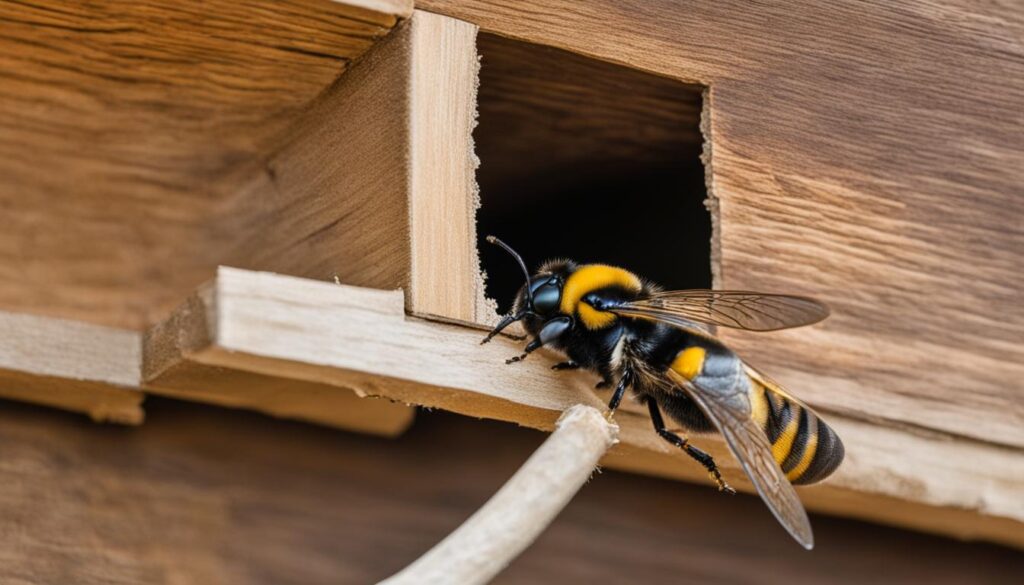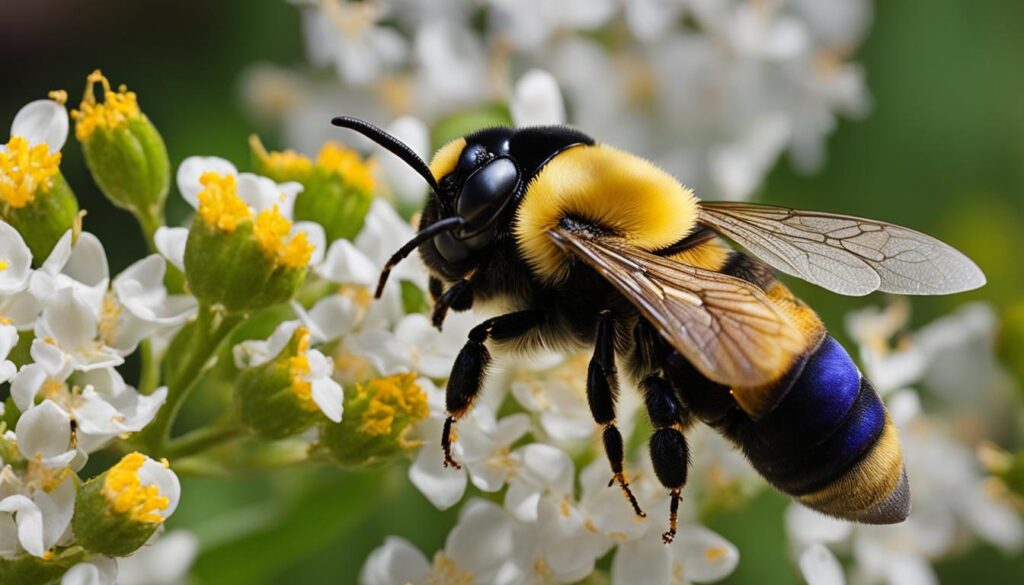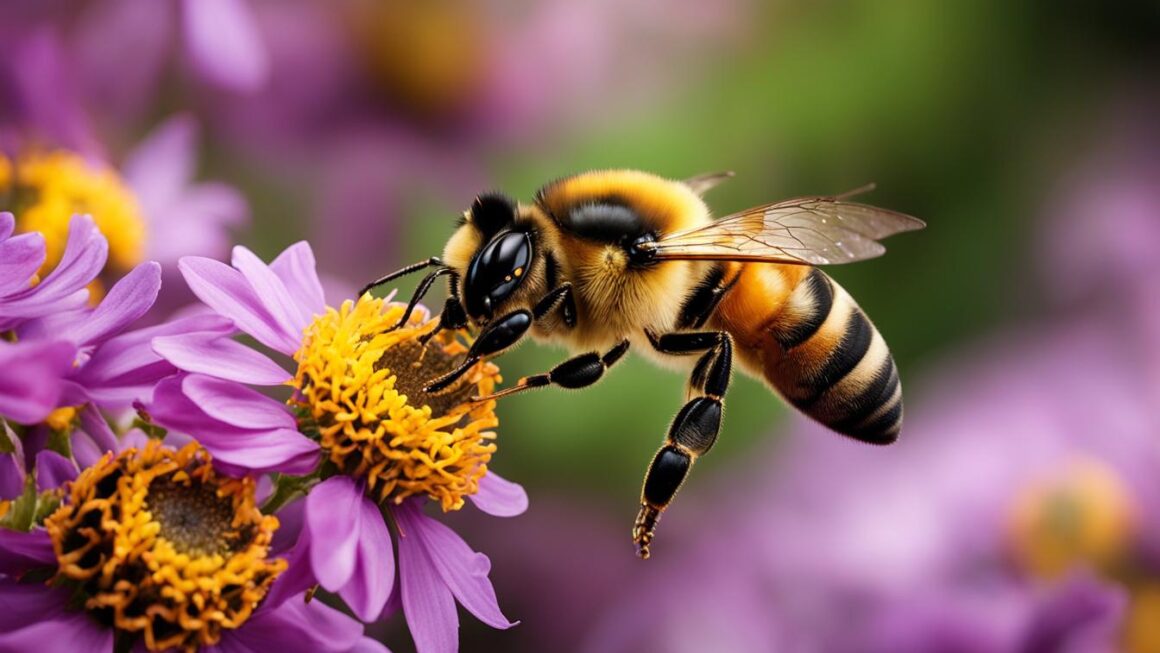When it comes to carpenter bees, one common question arises: do they sting? Let’s delve into the fascinating world of these buzzing creatures to find out the truth about their sting potential.
Key Takeaways:
- Male carpenter bees do not have stingers and cannot sting.
- Female carpenter bees have stingers and can deliver a painful sting if threatened or provoked.
- Carpenter bees are generally non-aggressive and prefer to avoid conflicts.
- Understanding their behavior and taking preventive measures can help minimize the chances of encounters.
- Respecting their space and implementing appropriate prevention strategies can create a safer environment for both humans and carpenter bees.
Male Carpenter Bees: Territorial Defenders
Male carpenter bees play a vital role in protecting their nesting sites. While they do not possess stingers and cannot sting, they exhibit territorial behavior to defend their territories. These industrious bees are committed to safeguarding their nests from potential threats, such as other insects or animals. By maintaining a strong presence around their nesting areas, they deter intruders and ensure the safety of their offspring.
This territorial behavior is a fascinating aspect of male carpenter bee behavior. They are known to patrol and hover near their nesting sites, surveying the surroundings for any signs of danger. The presence of male carpenter bees can act as a deterrent to potential predators or intruders, helping to maintain the integrity of their nesting sites.
Male Carpenter Bees: A Formidable Presence
While male carpenter bees lack stingers, their aggressive territorial behavior is an impressive display of their dedication to protecting their nests. They are driven by their instinct to ensure the survival of their species, and their commitment to defending their territories is a testament to their importance in the carpenter bee community.
Comparing Male and Female Carpenter Bee Behavior
| Behavior | Male Carpenter Bees | Female Carpenter Bees |
|---|---|---|
| Stinging Ability | No stingers, cannot sting | Have stingers, can sting if provoked |
| Territorial Behavior | Defend nesting sites from intruders | Focus on nesting activities |
| Primary Role | Protecting the nest and offspring | Excavating, egg-laying, and provisioning for offspring |
Understanding the distinct behaviors of male and female carpenter bees provides valuable insights into their roles within the carpenter bee community. While male carpenter bees are territorial defenders without stingers, female carpenter bees focus primarily on nesting activities and have the ability to sting if provoked. Their combined efforts contribute to the overall success and survival of the carpenter bee species.
Female Carpenter Bees: Potential Stingers
Female carpenter bees, unlike their male counterparts, have stingers and can deliver a painful sting if they feel threatened or provoked. However, it is important to note that female carpenter bees are generally non-aggressive insects. They focus primarily on nesting activities, such as excavation, egg-laying, and provisioning for their offspring. Their stinging behavior is primarily a defensive response to protect their nests and themselves.
It is crucial to understand the factors that may lead to a defensive response from female carpenter bees. Disturbing the bees by swatting at them or directly handling them can provoke a sting. Approaching their nests, especially during entry or exit, can also trigger a defensive response. Sudden movements or vibrations near their nesting areas can make them feel threatened and more likely to sting.
Factors That May Provoke a Sting
To further clarify the factors that may provoke a sting from female carpenter bees, let’s take a look at the following table:
| Factors | Potential to Provoke a Sting |
|---|---|
| Swatting or directly handling the bees | High |
| Approaching their nests during entry or exit | High |
| Sudden movements or vibrations near their nesting areas | Medium |
By understanding these factors and taking precautions, such as maintaining a respectful distance from carpenter bees and their nests, you can minimize the risk of getting stung. It is essential to coexist with these fascinating creatures while ensuring your safety and theirs.
Factors That May Provoke a Sting
Various factors can provoke a sting from carpenter bees. Understanding these triggers can help you avoid any unwanted encounters and minimize the risk of a painful sting. Here are some common situations that may provoke a defensive response from carpenter bees:
- Directly handling or swatting the bees: Carpenter bees are sensitive to sudden movements and may perceive them as threats. Avoid touching or swatting the bees to prevent them from feeling provoked.
- Approaching their nests: Carpenter bees are protective of their nests and may become defensive if someone gets too close. Avoid approaching or tampering with their nest areas, especially during their entry or exit times.
- Movements or vibrations near nesting areas: Carpenter bees are attuned to vibrations in their surroundings. Loud noises, machinery, or any sudden disturbances near their nesting areas may trigger a defensive response.
It’s important to note that while carpenter bees can sting, they are generally non-aggressive insects. They prefer to focus on their nesting activities rather than seeking confrontation with humans. However, it’s always wise to take precautions and respect their space to avoid any potential stings.

To prevent provoking carpenter bees and minimize the chances of a sting, it is recommended to:
- Stay calm and move slowly around carpenter bees.
- Avoid direct physical contact with the bees.
- Keep a safe distance from their nests and nesting areas.
- Implement preventive measures such as sealing existing holes and cracks in wooden structures.
- Use natural deterrents like planting herbs with strong smells, such as mint, eucalyptus, or marigolds, near potential nesting areas.
- Consider professional assistance if you have persistent carpenter bee infestations.
By being mindful of these factors and taking proactive steps towards prevention, you can coexist peacefully with carpenter bees and reduce the risk of stings.
Treatment and Prevention of Carpenter Bee Stings
If you find yourself dealing with a carpenter bee sting, quick and appropriate action can help alleviate discomfort and reduce the risk of complications. Here are some steps you can take:
- Stay calm: It’s important to stay calm and avoid excessive movement, as this can aggravate the sting and increase pain.
- Remove the stinger: If the stinger is still embedded in the skin, gently scrape it out using a credit card or a similar flat object. Avoid using tweezers to prevent further venom injection.
- Clean the area: Wash the affected area with mild soap and water to prevent infection.
- Apply a cold compress: Applying a cold compress or ice pack wrapped in a cloth can help reduce pain, swelling, and inflammation.
- Consider over-the-counter pain relief: If necessary, you can take over-the-counter pain relievers, such as acetaminophen or ibuprofen, to help manage pain and discomfort. Follow the recommended dosage instructions and consult a healthcare professional if you have any underlying medical conditions or concerns.
Preventing carpenter bee stings involves taking proactive measures to deter these insects and protect yourself from potential encounters. Here are some prevention strategies:
- Fill existing holes: If you have identified carpenter bee holes in wooden structures, fill them with wood putty or caulk to discourage new nesting activities.
- Use natural deterrents: Planting herbs like mint, eucalyptus, or marigolds near potential nesting areas can help deter carpenter bees due to their dislike for strong smells.
- Seek professional assistance: If you are dealing with persistent carpenter bee infestations that pose a threat to your property or well-being, consider contacting a professional pest control service. They can provide expert advice and implement effective control measures.
| Treatment Steps | Prevention Strategies |
|---|---|
| Stay calm | Fill existing holes |
| Remove the stinger | Use natural deterrents |
| Clean the area | Seek professional assistance |
| Apply a cold compress | |
| Consider over-the-counter pain relief |
By following these treatment and prevention measures, you can effectively manage carpenter bee stings and minimize the chances of future encounters. Remember, carpenter bees play an important ecological role, so it’s essential to find a balance between coexistence and protecting your home and well-being.
What Do Carpenter Bees Hate the Most?
Carpenter bees dislike strong smells and certain materials can deter them from nesting in specific areas. By taking advantage of their aversion to certain scents and using appropriate materials, you can discourage carpenter bees from choosing your property as a nesting site.
Mint, Eucalyptus, and Marigolds
One effective way to repel carpenter bees is by planting herbs like mint, eucalyptus, or marigolds near potential nesting areas. These plants emit strong aromas that carpenter bees find unpleasant. By incorporating these fragrant plants into your garden or landscape, you can create an environment that discourages carpenter bees from settling in.
Treated Wood
Carpenter bees are less attracted to wood that has been treated with sealants, varnish, or paint. These coatings create a barrier that makes the wood less appealing for nesting. If you have wooden structures or furniture in outdoor areas prone to carpenter bee activity, consider treating them to make them less attractive to these insects.
Summary Table: Materials that Deter Carpenter Bees
| Material | Description |
|---|---|
| Mint, Eucalyptus, and Marigolds | Fragrant plants that produce scents disliked by carpenter bees |
| Treated Wood | Wood that has been coated with sealants, varnish, or paint to make it less appealing for nesting |
By incorporating these natural deterrents and utilizing treated wood in outdoor areas, you can create an environment that is less welcoming to carpenter bees. However, it’s important to note that these methods may not guarantee complete prevention, as carpenter bees may still explore the area before determining whether it suits their nesting needs. Implementing these preventive measures can be a proactive step towards reducing carpenter bee activity on your property.

Are Carpenter Bees Aggressive?
Carpenter bees are generally non-aggressive insects, but it’s important to understand their behavior to coexist harmoniously. Male carpenter bees exhibit territorial behavior, defending their nesting sites from other insects or animals. However, they do not possess stingers and cannot sting. Their primary focus is on protecting their territory rather than seeking confrontation with humans.
Female carpenter bees, on the other hand, have stingers and can sting if they feel threatened or provoked. However, they are generally non-aggressive and will only sting in self-defense or to protect their nests. Their main focus is on nesting activities such as excavation, egg-laying, and provisioning for their offspring.
It’s essential to respect carpenter bees’ space and avoid actions that may provoke a defensive response. Factors that may provoke a sting include disturbing the bees through swatting or directly handling them, approaching their nests, and sudden movements or vibrations near their nesting areas. By taking precautions and being mindful of their presence, you can minimize the chances of encounters and maintain a peaceful coexistence.
Understanding carpenter bees’ behavior and their non-aggressive nature can help dispel misconceptions and fears associated with these insects. While they may exhibit territorial and defensive behaviors, they prefer to avoid conflicts and focus on their nesting activities. By creating a safe environment and implementing appropriate prevention strategies, such as sealing holes and using natural deterrents, you can ensure a peaceful coexistence with these fascinating creatures.
What Does a Carpenter Bee Sting Look Like?
A carpenter bee sting can cause discomfort and leave noticeable marks on the skin. When a carpenter bee stings, it injects venom into the skin, leading to a localized reaction. The appearance of a carpenter bee sting can vary depending on the individual’s sensitivity and the severity of the reaction.
The area where the bee stings typically becomes red, swollen, and may feel warm to the touch. A raised welt or bump forms around the site of the sting, similar to other insect stings. The size and intensity of the welt can vary, with some individuals experiencing a small, mild reaction, while others may develop larger, more pronounced swelling. The affected area may also be tender or itchy.
It’s essential to note that carpenter bee stings are generally not as painful or intense as some other stinging insects, such as wasps or hornets. However, some individuals may have an allergic reaction to the venom, which can result in more severe symptoms. If an allergic reaction is suspected, immediate medical attention should be sought.
| Signs and Symptoms of a Carpenter Bee Sting |
|---|
| Redness and swelling at the site of the sting |
| Raised welt or bump on the skin |
| Tenderness or itchiness |
| Possible allergic reaction (rare) |
If you have been stung by a carpenter bee, it’s important to clean the area with mild soap and water to reduce the risk of infection. Applying a cold compress or ice pack wrapped in a cloth can help alleviate swelling and provide temporary relief. Over-the-counter pain relievers can also be used to manage any discomfort.
Remember, prevention is key when it comes to carpenter bee stings. By taking proactive measures to deter carpenter bees from nesting in or around your property, you can minimize the chances of encountering these insects and reduce the risk of being stung.
Conclusion
In conclusion, carpenter bees have the potential to sting, but their behavior is generally non-aggressive. Male carpenter bees, although territorial defenders, do not have stingers and cannot sting. Female carpenter bees, on the other hand, have stingers but will only use them if they feel threatened or provoked. Understanding these behaviors can help promote a peaceful coexistence.
To prevent encounters and minimize the risk of stings, it is important to take proactive measures. This includes filling existing holes in wood structures, using natural deterrents such as mint or eucalyptus plants, and seeking professional assistance for persistent infestations. By respecting the carpenter bees’ space and implementing these prevention strategies, you can create a safer environment for both yourself and the bees.
Remember that if a sting does occur, prompt action can alleviate discomfort and reduce complications. Stay calm, remove the stinger if present, clean the area, and apply a cold compress. Over-the-counter pain relief may also be considered. By understanding carpenter bees’ behavior, taking preventive measures, and knowing how to respond to stings, you can effectively manage their presence while ensuring your own wellbeing.
FAQ
Do carpenter bees sting?
Yes, carpenter bees can sting. However, their stinging behavior varies between males and females.
Can male carpenter bees sting?
No, male carpenter bees do not have stingers and cannot sting.
Do female carpenter bees have stingers?
Yes, female carpenter bees have stingers and can deliver a painful sting if threatened or provoked.
What factors may provoke a sting from carpenter bees?
Disturbing the bees, approaching their nests, or sudden movements near their nesting areas can provoke a defensive response.
How should I treat a carpenter bee sting?
Prompt action includes staying calm, removing the stinger if present, cleaning the area, applying a cold compress, and considering over-the-counter pain relief.
How can I prevent carpenter bee stings?
Prevention involves filling existing holes, using natural deterrents, and seeking professional assistance for persistent infestations.
What do carpenter bees dislike the most?
Carpenter bees dislike strong smells, and certain materials like treated wood or planting herbs such as mint, eucalyptus, or marigolds can deter them.
Are carpenter bees aggressive?
Carpenter bees are generally non-aggressive insects. While male carpenter bees may exhibit territorial behavior, they do not possess stingers and cannot sting. Female carpenter bees will only sting if they feel threatened or provoked.
What does a carpenter bee sting look like?
A carpenter bee sting appears as a raised welt on the skin, similar to other insect stings. It may be red, swollen, and tender to the touch.




